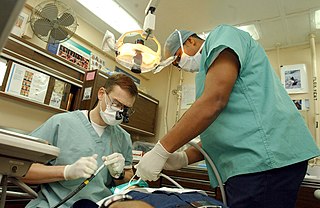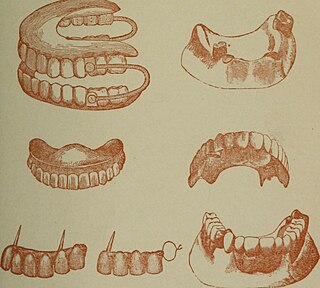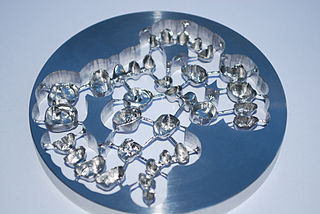
Dentistry, also known as dental medicine and oral medicine, is the branch of medicine focused on the teeth, gums, and mouth. It consists of the study, diagnosis, prevention, management, and treatment of diseases, disorders, and conditions of the mouth, most commonly focused on dentition as well as the oral mucosa. Dentistry may also encompass other aspects of the craniofacial complex including the temporomandibular joint. The practitioner is called a dentist.

A dentist, also known as a dental surgeon, is a health care professional who specializes in dentistry, the branch of medicine focused on the teeth, gums, and mouth. The dentist's supporting team aids in providing oral health services. The dental team includes dental assistants, dental hygienists, dental technicians, and sometimes dental therapists.

A dental technician is a member of the dental team who, upon prescription from a dental clinician, constructs custom-made restorative and dental appliances.

A dental implant is a prosthesis that interfaces with the bone of the jaw or skull to support a dental prosthesis such as a crown, bridge, denture, or facial prosthesis or to act as an orthodontic anchor. The basis for modern dental implants is a biological process called osseointegration, in which materials such as titanium or zirconia form an intimate bond to the bone. The implant fixture is first placed so that it is likely to osseointegrate, then a dental prosthetic is added. A variable amount of healing time is required for osseointegration before either the dental prosthetic is attached to the implant or an abutment is placed which will hold a dental prosthetic/crown.

Clear aligners are orthodontic devices that are a transparent, plastic form of dental braces used to adjust teeth.
Hypodontia is defined as the developmental absence of one or more teeth excluding the third molars. It is one of the most common dental anomalies, and can have a negative impact on function, and also appearance. It rarely occurs in primary teeth and the most commonly affected are the adult second premolars and the upper lateral incisors. It usually occurs as part of a syndrome that involves other abnormalities and requires multidisciplinary treatment.

The UCLA School of Dentistry is the dental school of the University of California, Los Angeles (UCLA) located in the Center for Health Sciences building in the Westwood neighborhood of Los Angeles, California, United States. The school has several educational and training programs, conducts oral and dental health research, and offers affordable dental care at three locations: Westwood, Venice, and Inglewood. The school also participates in several outreach endeavors, including numerous health fairs during the year, STEM pipeline programs and provides dental care for underserved populations in the region. The School of Dentistry is considered among the nation's best research-intensive dental schools.
Henry Schein, Inc. is an American distributor of health care products and services with a presence in 32 countries. The company is a Fortune World's Most Admired Company and is ranked number one in its industry for social responsibility by Fortune magazine. Ethisphere named Henry Schein as one of the 2023 World's Most Ethical Companies for the 12th consecutive year.

Nobel Biocare is a Swiss company originally founded in Sweden for manufacturing dental implants. It is now headquartered in Kloten, Switzerland near the Zürich Airport. Nobel Biocare in its current form was founded in 2002. It originates from a partnership formed in 1978 between Swedish medical researcher Professor Per-Ingvar Brånemark and Bofors, a Swedish company, to industrialize Brånemark's discovery of osseointegration. Beside dental implants, it also presently develops and commercializes CAD/CAM-based prosthetics equipments to scan teeth and to fabricate individualized dental prosthesis using digital technologies in place of silicone molding.

A denturist in the United States and Canada, clinical dental technologist in the United Kingdom and Ireland, dental prosthetist in Australia, or a clinical dental technician in New Zealand is a member of the oral health care team and role as primary oral health care provider who provides an oral health examination, planning treatment, takes impressions of the surrounding oral tissues, constructs and delivers removable oral prosthesis treatment directly to the patient.

CAD/CAM dentistry is a field of dentistry and prosthodontics using CAD/CAM to improve the design and creation of dental restorations, especially dental prostheses, including crowns, crown lays, veneers, inlays and onlays, fixed dental prostheses (bridges), dental implant supported restorations, dentures, and orthodontic appliances. CAD/CAM technology allows the delivery of a well-fitting, aesthetic, and a durable prostheses for the patient. CAD/CAM complements earlier technologies used for these purposes by any combination of increasing the speed of design and creation; increasing the convenience or simplicity of the design, creation, and insertion processes; and making possible restorations and appliances that otherwise would have been infeasible. Other goals include reducing unit cost and making affordable restorations and appliances that otherwise would have been prohibitively expensive. However, to date, chairside CAD/CAM often involves extra time on the part of the dentist, and the fee is often at least two times higher than for conventional restorative treatments using lab services.
Dental pertains to the teeth, including dentistry. Topics related to the dentistry, the human mouth and teeth include:
Synthes Holding AG is a multinational medical device manufacturer based in Solothurn, Switzerland and West Chester, Pennsylvania, United States. It is the world's largest maker of implants to mend bone fractures, and also produces surgical power tools and advanced biomaterials.
Ernest Sheldon Friel, was an Irish dentist who was the first specialist orthodontist to practise in the United Kingdom of Great Britain and Ireland, and the second in Europe, going on to become the first Professor of Orthodontics in Europe. His obituary in The Journal of the Irish Dental Association described him as the most distinguished dentist that Ireland had ever produced.
Digital dentistry refers to the use of dental technologies or devices that incorporates digital or computer-controlled components to carry out dental procedures rather than using mechanical or electrical tools. The use of digital dentistry can make carrying out dental procedures more efficient than using mechanical tools, both for restorative as diagnostic purposes. Used as a way to facilitate dental treatments and propose new ways to meet rising patient demands.

Ralf Johannes Radlanski is a German anatomist, orthodontist and university professor. Since 1992 he is director of the Dept. of Craniofacial Developmental Biology at the Center for Dental and Craniofacial Sciences, Charité – University Medicine Berlin (Germany). He is a guest professor at the University of California, San Francisco (USA), at the University of Turku (Finland), at the University of Queensland, Brisbane, at the University of Basle (Switzerland), and at the University of Zurich (Switzerland). He is a Dr. honoris causa at Coorg Institute of Dental Sciences Virajpet (India).
Osstell AB is a company headquartered in Gothenburg, Sweden that develops, manufactures, and sells devices and accessories used to measure dental implant stability. It was founded in 1999 with the aim of developing and commercializing a device that utilized resonance frequency analysis (RFA) to determine the level of stability of a dental implant.
The history of dental treatments dates back to thousands of years. The scope of this article is limited to the pre-1981 history.
Orthodontic indices are one of the tools that are available for orthodontists to grade and assess malocclusion. Orthodontic indices can be useful for an epidemiologist to analyse prevalence and severity of malocclusion in any population.
A root-analogue dental implant (RAI) – also known as a truly anatomic dental implant, or an anatomical/custom implant – is a medical device to replace one or more roots of a single tooth immediately after extraction. In contrast to common titanium screw type implants, these implants are custom-made to exactly match the extraction socket of the specific patient. Thus there is usually no need for surgery.









